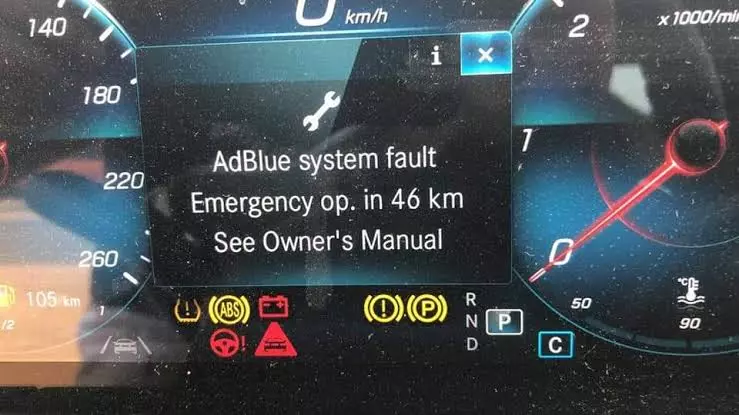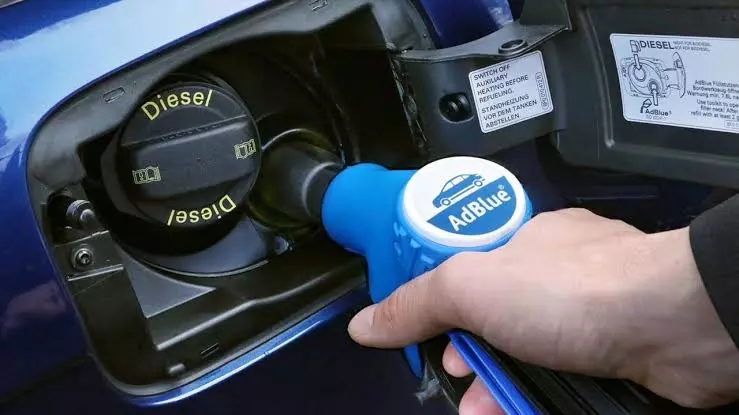What’s The P13DF Mercedes Fault Code?
Vehicles comprise several mechanical parts that often experience technical problems. Because of the many components, it can be very difficult to identify any source of a problem in case your car exhibits any.
Therefore, modern technological advancements in the automotive industry have come up with a more sophisticated way to help detect mechanical faults in a car.
This is done through an onboard computer in a car that receives signals in case any of the mechanical parts are faulty. The signals are then displayed as fault codes on the computer.
Different codes signify different mechanical problems and can be retrieved using the OBD II Scanner to help in diagnosis. The focus of this article is the P13DF Mercedes fault code.

Table Of Content
- Code P13DF Meaning
- What is the mechanism behind it?
- Common Problems With AdBlue System
- Warning System For AdBlue Faults
- Troubleshooting Fault Code P13DF
- What's the best way to restock AdBlue?
- Conclusion
1. Code P13DF Meaning
Code P13DF implies a Mercedes AdBlue faulty sensor in the AdBlue system. The AdBlue sensors in this system helps to monitor the exhaust system by ensuring that it records the pressure of the AdBlue fluid (a non-toxic fluid made of 33% synthetic urea and 67% deionized water) which can affect its injection.

The AdBlue fluid or Diesel Exhaust Fluid (DEF) helps to lower Nitrogen Oxide emissions as part of the exhaust treatment system called Selective Catalytic Reduction (SCR).
The process helps convert the harmful exhaust gasses into nitrogen and water, hence compliance with EPA emissions standards for all cars.
2. What Is The Mechanism Behind AdBlue System?
AdBlue is kept in a separate external tank with its distribution pump. It is then injected into the exhaust gas stream through the injection valve. The heater element is inserted into the tank to prevent AdBlue from freezing in low outdoor temperatures.
The Electronic Diesel Control unit, or EDC, is in charge of activation and AdBlue dosing. This restriction is based on many factors, which include::
- The temperature of the exhaust
- The amount of NOx produced before and after the SCR catalytic converter
- The AdBlue system's operational readiness
Keep in mind that the AdBlue system in your Mercedes will only start working once all the conditions have been met.
3. Common Problems With AdBlue System
Despite its simplicity, this technology is extremely sensitive and delicate. The following are some of the most common flaws:
-
A heater element in the tank that burns out. The only way to fix it is to get a new one.
-
Clogged injector and connecting tubing If you take numerous short trips, the urea solution can crystallize because this device only functions at high exhaust temperatures.
-
The NOx sensor can malfunction and give false readings.

4. Warning System For AdBlue Faults
If the AdBlue system fails, your Mercedes will be limited to a certain number of starts or kilometers driven before it may be restarted.
It is critical to address any faults with the AdBlue system as soon as possible.
You may receive one or more of the following messages, depending on the model of your Mercedes car:
- AdBlue Check Additive See Operator’s Manual

- AdBlue Range
- Engine Start Not Permitted (AdBlue Empty)
- Check AdBlue No engine Start Possible in XXX miles/km.
- Check AdBlue Remaining starts: X
While there are methods for resetting the Mercedes limited start condition, it is more necessary to identify the source of the problem and repair a malfunctioning AdBlue system. The following are the two most prevalent AdBlue issues:
- Low DEF fluid level
- There is a problem with the SCR system.
An AdBlue system that fails for any reason will have no effect on the engine's operation or performance. Without AdBlue, you may easily drive for years without harming your engine. That only works in theory, because a Mercedes BlueTec from 2010 or later is more likely to go into limp mode, preventing you from driving.

Mercedes-Benz BlueTec automobiles and Sprinter vans from 2009 and before may go over 300,000 miles with the original engine. The AdBlue system was not installed in these vehicles.
So, if the AdBlue system isn't working, why are you getting numerous warnings? Well, the answer is simple: that is the only thing that will keep you from driving your Mercedes in that manner.
Most automobile owners would not top-up DEF when it runs out if there was a warning system like this countdown. And this would result in more pollution and emissions.
5. Troubleshooting Fault Code P13DF
First and foremost, check the AdBlue level and replenish it if necessary. AdBlue fluid can be purchased from any Mercedes dealer, or a generic Diesel Exhaust Fluid can be purchased at auto parts stores or gas stations.
If there is a problem with the system, make sure to check the following:
-
Temperature sensor values upstream of the SCR catalytic converter
-
NOx sensor control unit values upstream of the SCR catalytic converter
-
NOx sensor control unit values downstream of the SCR catalytic converter
-
DEF quality and quantity in the AdBlue tank
-
AdBlue injection valve and delivery pump
-
The amount of AdBlue metering
-
Look for leaks visually.
6. What's The Best Way To Restock AdBlue?
It's as simple as putting gas in your car. Next to the gasoline filler cap is a DEF tank filler. Simply open the gas cap and look for the blue-colored cap. Remove the cap and fill the tank with your preferred Diesel Exhaust Fluid.
Make sure you're putting AdBlue in the right tank. AdBlue should not be used with diesel fuel. AdBlue isn't a lubricant or an additive. Do not combine AdBlue with water.

7. Conclusion
Up to 90% of the toxic nitrogen oxides created by the car are converted into nitrogen and water through the AdBlue system process.
Modern diesel-powered cars combine this with various emission control systems to meet the strictest emissions regulations while maintaining high engine power and fuel economy.
Therefore, it is important to diagnose diagnostic trouble code P13DF urgently before the problem becomes severe and stalls your engine completely.
You have also to ensure that your car upholds compliance with EPA standards on emission. Failure to, your car may be impounded and have hefty fines slapped on you.